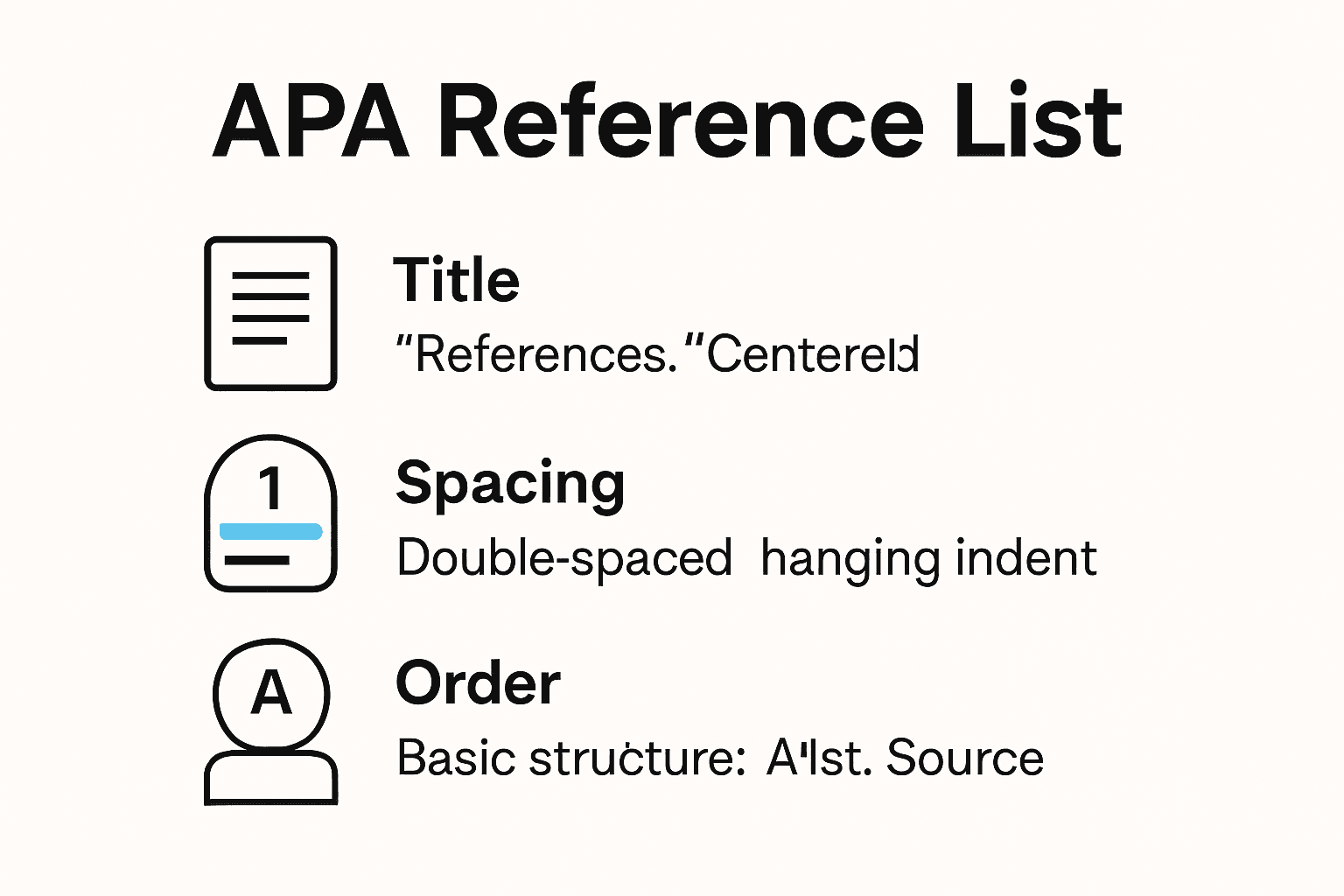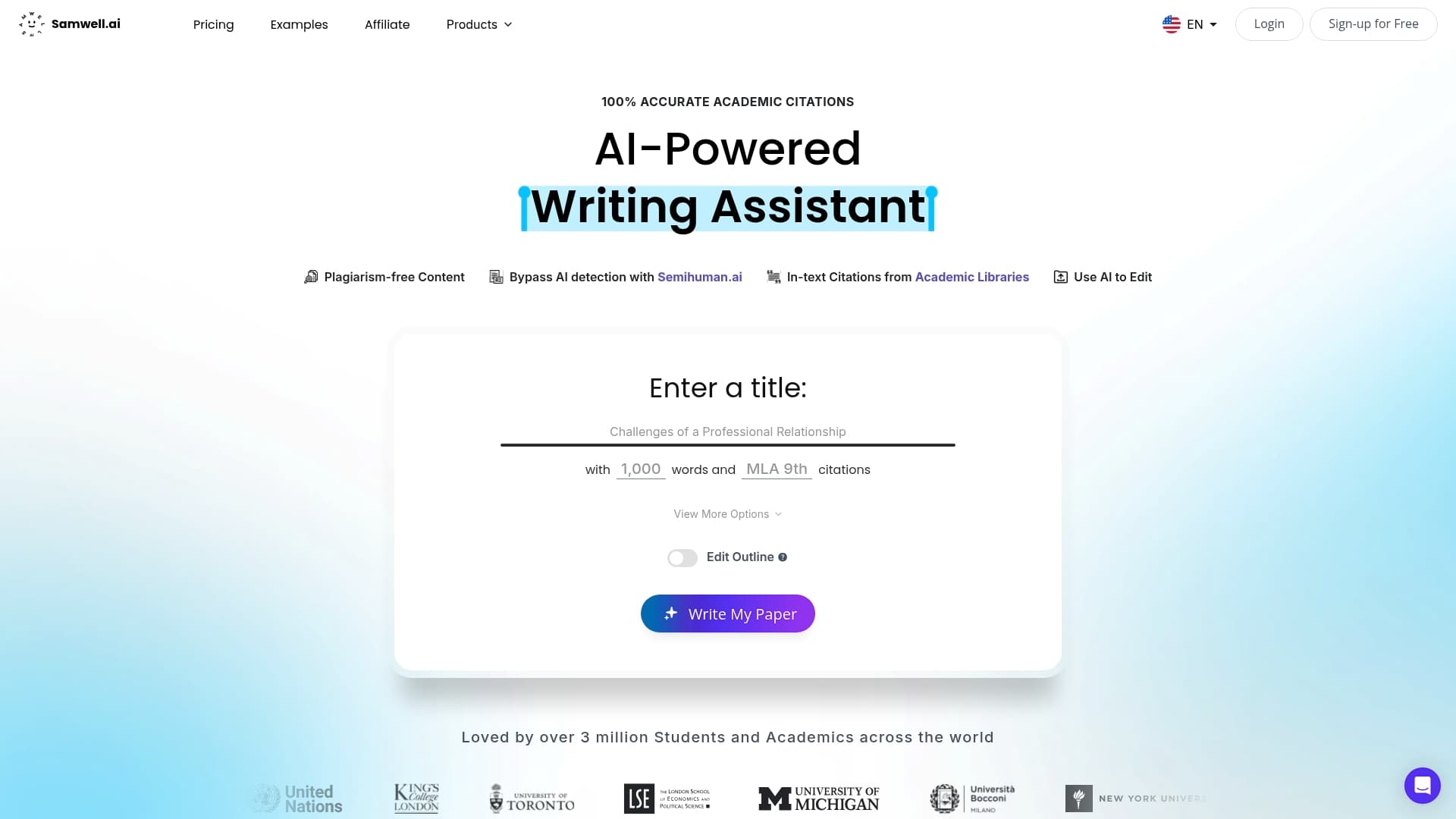Blog
Learning Materials
APA Guidelines for References 2025: A Simple Guide
Updated: July 24, 2025

APA reference mistakes can tank a whole research paper, even if your arguments are solid and your insights are original. Surprisingly, nearly 40 percent of university students lose crucial points for errors in their reference list alone. Most people think APA referencing is all about memorizing a few citation rules and moving on. The real secret is that one small formatting slip can cost you academic credibility, so mastering these details is not optional.
Table of Contents
- Apa Reference List Rules And Structure Dockerfile README.md email-templates i18n-config.ts i18nConfig.ts next-sitemap-samwell.config.js next-sitemap-semihuman.config.js next.config.js node_modules package-lock.json package.json process_content.js public scripts src svgr.d.ts translations tsconfig.json Basic Reference List Requirements Dockerfile README.md email-templates i18n-config.ts i18nConfig.ts next-sitemap-samwell.config.js next-sitemap-semihuman.config.js next.config.js node_modules package-lock.json package.json process_content.js public scripts src svgr.d.ts translations tsconfig.json Organizing And Arranging References Dockerfile README.md email-templates i18n-config.ts i18nConfig.ts next-sitemap-samwell.config.js next-sitemap-semihuman.config.js next.config.js node_modules package-lock.json package.json process_content.js public scripts src svgr.d.ts translations tsconfig.json Matching In Text Citations With References
- How To Format Common Source Types In Apa Dockerfile README.md email-templates i18n-config.ts i18nConfig.ts next-sitemap-samwell.config.js next-sitemap-semihuman.config.js next.config.js node_modules package-lock.json package.json process_content.js public scripts src svgr.d.ts translations tsconfig.json Journal Articles And Academic Sources Dockerfile README.md email-templates i18n-config.ts i18nConfig.ts next-sitemap-samwell.config.js next-sitemap-semihuman.config.js next.config.js node_modules package-lock.json package.json process_content.js public scripts src svgr.d.ts translations tsconfig.json Books, Chapters, And Electronic Sources Dockerfile README.md email-templates i18n-config.ts i18nConfig.ts next-sitemap-samwell.config.js next-sitemap-semihuman.config.js next.config.js node_modules package-lock.json package.json process_content.js public scripts src svgr.d.ts translations tsconfig.json Specialized Sources And Complex References
- Frequent Mistakes To Avoid With Apa References Dockerfile README.md email-templates i18n-config.ts i18nConfig.ts next-sitemap-samwell.config.js next-sitemap-semihuman.config.js next.config.js node_modules package-lock.json package.json process_content.js public scripts src svgr.d.ts translations tsconfig.json Incorrect Citation Formatting Dockerfile README.md email-templates i18n-config.ts i18nConfig.ts next-sitemap-samwell.config.js next-sitemap-semihuman.config.js next.config.js node_modules package-lock.json package.json process_content.js public scripts src svgr.d.ts translations tsconfig.json Inconsistent And Incomplete References Dockerfile README.md email-templates i18n-config.ts i18nConfig.ts next-sitemap-samwell.config.js next-sitemap-semihuman.config.js next.config.js node_modules package-lock.json package.json process_content.js public scripts src svgr.d.ts translations tsconfig.json Digital Source And Overcitation Challenges
- Helpful Tools And Resources For Apa Compliance Dockerfile README.md email-templates i18n-config.ts i18nConfig.ts next-sitemap-samwell.config.js next-sitemap-semihuman.config.js next.config.js node_modules package-lock.json package.json process_content.js public scripts src svgr.d.ts translations tsconfig.json Online Citation Generators And Management Tools Dockerfile README.md email-templates i18n-config.ts i18nConfig.ts next-sitemap-samwell.config.js next-sitemap-semihuman.config.js next.config.js node_modules package-lock.json package.json process_content.js public scripts src svgr.d.ts translations tsconfig.json Academic Writing And Compliance Platforms Dockerfile README.md email-templates i18n-config.ts i18nConfig.ts next-sitemap-samwell.config.js next-sitemap-semihuman.config.js next.config.js node_modules package-lock.json package.json process_content.js public scripts src svgr.d.ts translations tsconfig.json Reference Verification And Validation Resources
Quick Summary
| Takeaway | Explanation |
|---|---|
| Follow strict APA formatting rules | Use consistent structure for author names, publication dates, and titles in your references. |
| Organize references alphabetically | Arrange entries by the last name of the first author to improve clarity. |
| Match in-text citations with references | Ensure the details in citations match those in the reference list to maintain credibility. |
| Utilize online citation tools | Tools like Zotero and EndNote can automate formatting and reduce errors. |
| Avoid common citation mistakes | Double-check for proper punctuation, capitalization, and completeness in your references. |
APA Reference List Rules and Structure
Creating an accurate and professional reference list is fundamental to academic writing. The American Psychological Association (APA) provides specific guidelines that ensure consistency and clarity in documenting sources.
Basic Reference List Requirements
The foundation of an APA reference list lies in its meticulous formatting and organization. According to Purdue University's Writing Center, the reference list begins on a new page with the title 'References' centered and bolded at the top. Every entry must follow a consistent structure that includes critical elements such as author names, publication dates, titles, and source information.
Each reference should be formatted with a hanging indent, where the first line is flush with the left margin and subsequent lines are indented. This creates a clean and professional appearance that makes it easy for readers to scan and locate specific sources. Double spacing between entries is mandatory, which helps maintain readability and aligns with APA's standard formatting guidelines.

Organizing and Arranging References
The alphabetical arrangement of references is a critical aspect of APA style. As APA Style's official guidelines emphasize, entries are organized by the last name of the first author. When multiple works by the same author exist, they are typically arranged chronologically, with the earliest publication listed first.
Specific rules govern how different types of sources are cited. Academic journal articles, books, websites, conference proceedings, and other sources each have unique citation requirements. For instance, a journal article reference includes the author's last name, initials, publication year, article title, journal name, volume number, issue number, and page range. Precision in these details ensures that other researchers can easily locate and verify the original sources.
Matching In Text Citations with References
A fundamental principle of APA referencing is the direct connection between in text citations and the reference list. Every source mentioned within the body of the academic work must have a corresponding full reference at the end of the document. This creates a comprehensive and transparent record of the research sources used.
Researchers must ensure that the author names and publication years in parenthetical or narrative citations exactly match the entries in the reference list. Consistency is key. Incomplete or incorrect references can undermine the credibility of academic work and potentially be viewed as a form of academic misconduct.
Mastering APA reference list rules requires attention to detail and practice. While the guidelines might seem complex initially, they provide a standardized method for acknowledging intellectual contributions and facilitating academic communication.
To help visualize the fundamental requirements, here is a summary table of APA reference list essentials:
| Requirement | Description |
|---|---|
| Title Page | Start reference list on a new page titled 'References', centered and bolded |
| Structure | Author(s), publication year, title, source details in a set format |
| Hanging Indent | First line flush left, subsequent lines indented |
| Alphabetization | Arrange entries alphabetically by first author's last name |
| Double Spacing | Double-space all entries, both within and between references |
| Complete Information | Include all key details (authors, date, title, source) |
How to Format Common Source Types in APA
Navigating the intricacies of APA reference formatting requires understanding the specific requirements for different source types. Researchers and students must pay close attention to the nuanced details that distinguish each reference entry.
Journal Articles and Academic Sources
Formatting journal article references demands precision. According to Purdue University's Online Writing Lab, a standard journal article reference includes several key components: author's last name and initials, publication year in parentheses, article title, journal name in italics, volume number in italics, issue number in parentheses, and page range.
For example, a typical journal article reference would look like this: Smith, J. D. (2023). Cognitive processing in academic writing. Journal of Academic Research, 45(2), 123-145. Note the specific placement of italics, punctuation, and capitalization rules that APA mandates.
Books, Chapters, and Electronic Sources
Book references require a slightly different approach. APA Style's official guidelines highlight that book references should include the author's name, publication year, book title in italics, and publication location and publisher. For edited books or book chapters, additional details like editor names and chapter titles become crucial.
Electronic sources present unique challenges. Websites, online articles, and digital resources need specific information including the URL and date of access. When citing online sources, researchers must include the digital object identifier (DOI) if available, which provides a permanent link to the source. For instance, a web article might be cited as: Johnson, M. (2024). Digital research trends. Retrieved from https://example.com/article on January 15, 2025.
Specialized Sources and Complex References

Some sources require more complex formatting. Conference proceedings, government documents, technical reports, and multimedia sources each have specific citation guidelines. The University of Wisconsin–Madison Writing Center emphasizes the importance of capturing all relevant publication information while maintaining a consistent structure.
Multimedia sources like YouTube videos, podcast episodes, or social media posts require careful attention to detail. These references typically include the creator's name, date of publication, title of the work, and the platform or source URL. For example, a podcast reference might look like: Rodriguez, A. (Host). (2024, March 15). Academic writing strategies [Audio podcast episode]. In Research Insights Podcast. https://example.com/podcast
Mastering APA reference formatting is an essential skill for academic and professional writing. While the rules may seem complex, they ensure clarity, consistency, and proper attribution of sources. Researchers should always consult the most recent APA style guide and pay meticulous attention to the specific requirements of each source type.
The following table compares the core APA requirements for various common source types:
| Source Type | Key Elements Included in Citation |
|---|---|
| Journal Article | Author(s), year, article title, journal name (italicized), volume (italicized), issue (in parentheses), page range |
| Book | Author(s), year, book title (italicized), publisher |
| Book Chapter | Author(s), year, chapter title, editors, book title (italicized), page range, publisher |
| Website/Online | Author(s), year, article/page title, site name, URL, (DOI if available), access/retrieval date (if necessary) |
| Conference Proceed. | Author(s), year, title, conference name, location, publisher (if applicable) |
| Multimedia (Podcast, Video) | Creator/host, year/date, episode or content title, platform/source, URL |
Frequent Mistakes to Avoid with APA References
APA reference formatting demands precision and attention to detail. Even experienced researchers can inadvertently make errors that compromise the credibility of their academic work.
Incorrect Citation Formatting
One of the most common pitfalls in APA referencing involves improper citation formatting. According to Purdue University's Online Writing Lab, researchers frequently make mistakes with punctuation, capitalization, and source identification. For instance, many students incorrectly capitalize article titles or fail to use proper italicization for journal names and book titles.
Another frequent error is mishandling author names. APA style requires specific formatting for multiple authors. When a work has two authors, use '&' instead of 'and' in the reference list. For works with three or more authors, list the first author followed by 'et al.' in subsequent citations. These nuanced rules are often overlooked but crucial for maintaining reference accuracy.
Inconsistent and Incomplete References
Incomplete references can significantly undermine academic credibility. The University of Utah's Graduate School highlights that many researchers fail to include all necessary publication details. This includes missing DOI numbers for online sources, incomplete publication information, or omitting crucial elements like volume numbers for journal articles.
Researchers must ensure that every in-text citation has a corresponding full reference in the reference list. Mismatched or missing references create confusion and can be interpreted as potential academic misconduct. Double-checking each reference against the original source and verifying all publication details is essential.
Digital Source and Overcitation Challenges
Digital sources present unique referencing challenges. Walden University's Academic Guides emphasize the importance of correctly citing online resources. Common mistakes include using outdated URLs, failing to include retrieval dates for volatile web content, and incorrectly formatting digital object identifiers (DOIs).
Overcitation is another frequent issue. Not every statement requires a citation, and excessive referencing can disrupt the flow of academic writing. Researchers should cite sources strategically, focusing on key claims, data, or unique interpretations that require external validation. Conversely, undercitation can lead to accusations of plagiarism, so finding the right balance is crucial.
Mastering APA reference formatting requires consistent practice and careful attention to detail. While these guidelines might seem overwhelming, they ensure academic integrity and facilitate clear scholarly communication. Students and researchers should regularly consult the latest APA style guide and seek feedback from mentors or writing centers to refine their referencing skills.
Below is a checklist table summarizing common APA reference mistakes and how to avoid them:
| Common Mistake | How to Avoid It | Status Check |
|---|---|---|
| Incorrect punctuation or capitalization | Double-check article and journal/book title formatting | [ ] |
| Missing or incomplete publication data | Verify all required information is included | [ ] |
| Mismatched in-text and reference entries | Ensure every citation matches a complete list entry | [ ] |
| Wrong use of author formatting (et al., &, etc.) | Check author rules for number of authors | [ ] |
| Outdated or missing URLs/DOIs | Validate links and include DOI where available | [ ] |
| Overcitation or undercitation | Cite strategically; avoid both excess and omission | [ ] |
Helpful Tools and Resources for APA Compliance
Navigating APA reference guidelines requires more than just understanding the rules. Researchers and students can leverage numerous digital tools and resources to ensure accurate and compliant citations.
Online Citation Generators and Management Tools
Modern technology offers powerful solutions for managing references. APA Style's official resources provide a range of digital tools designed to simplify the citation process. Online citation generators like Zotero, Mendeley, and EndNote can automatically format references according to the latest APA guidelines, reducing manual formatting errors.
These digital platforms allow users to import sources directly from academic databases, web browsers, and digital libraries. By capturing publication details automatically, these tools minimize the risk of transcription errors and save significant time in research preparation. Many offer browser extensions and integrations with word processing software, creating a seamless citation workflow.
Academic Writing and Compliance Platforms
Beyond citation generators, comprehensive academic writing platforms provide robust support for APA compliance. Purdue University's Online Writing Lab offers free online guides and interactive resources that help researchers understand and apply APA formatting rules.
Some advanced platforms include plagiarism detection, grammar checking, and real-time formatting suggestions. These tools not only help with citations but also ensure overall document integrity. Researchers can receive immediate feedback on potential citation issues, improper formatting, and potential attribution problems before submitting their work.
Reference Verification and Validation Resources
Ensuring the accuracy of sources is crucial in academic writing. Digital resources like CrossRef and Google Scholar provide tools for verifying publication details, tracking citations, and confirming the existence of academic sources. These platforms help researchers validate source information and maintain the highest standards of academic integrity.
Library databases and institutional subscriptions offer additional layers of source verification. Many universities provide access to comprehensive research databases that allow quick cross-referencing of publication details. Researchers can use these resources to confirm author names, publication dates, and other critical citation elements.
Mastering APA references requires a combination of knowledge, practice, and the right technological support. While tools can significantly streamline the citation process, they should complement rather than replace a thorough understanding of APA guidelines. Researchers should continuously update their skills and remain familiar with the latest citation standards.
As academic writing evolves, so do the tools and resources supporting proper citation. Staying informed about new digital platforms and best practices ensures researchers can produce consistently high-quality, compliant academic documents.
Frequently Asked Questions
What are the basic requirements for an APA reference list?
The APA reference list should start on a new page titled 'References', centered and bolded. Each entry must include author names, publication dates, titles, and source information, formatted with a hanging indent and double spacing.
How should I organize my references in APA format?
References should be organized alphabetically by the last name of the first author. If multiple works by the same author exist, arrange them chronologically, with the earliest publication listed first.
How can I ensure my in-text citations match my reference list?
Consistency is crucial. Make sure that the author names and publication years in your in-text citations match the corresponding entries in your reference list to maintain academic credibility.
What common mistakes should I avoid when citing sources in APA format?
Some common mistakes include incorrect punctuation or capitalization, inconsistent or incomplete references, and using outdated URLs for digital sources. Always double-check your citations against APA guidelines.
Achieve Flawless APA References with AI-Powered Precision
Struggling with APA reference list rules and the fine details of citation formatting can be overwhelming. One small error may cost you essential marks or even affect your credibility. Making sure your reference list matches every in-text citation and follows precise APA structure is a common pain point, especially as the guidelines evolve each year. If you value your time and academic reputation, why not discover a smarter way to ensure your references are always perfect?

Start using Samwell.ai and let advanced Semihuman.ai technology manage your APA compliance, originality, and citation accuracy with zero stress. Instantly check your references, expand your research, and get real-time support as you write. With the Power Editor and built-in citation management, you can stop worrying about missed details and focus on your ideas. Experience how over a million students and academics at top universities maintain top grades and integrity. Try Samwell.ai now and turn your next paper into your strongest academic achievement.
Generate essays with Samwell.ai
Whether you’re a publisher, professor, journalist, or student, let us tailor a plan just for you.Most Read Articles

Your Guide to Help Writing a Essay Successfully
Expert tips for help writing a essay - from crafting a thesis to structuring your essay effectively.

How to Write Critical Thinking Essay: Expert Tips
Expert tips for writing a critical thinking essay. Learn how to structure, choose topics, and use evidence effectively.'

How to Write a Good Hook: A Step-by-Step Guide
Master the art of crafting a good hook with our guide. Create compelling openers for a memorable first impression.

